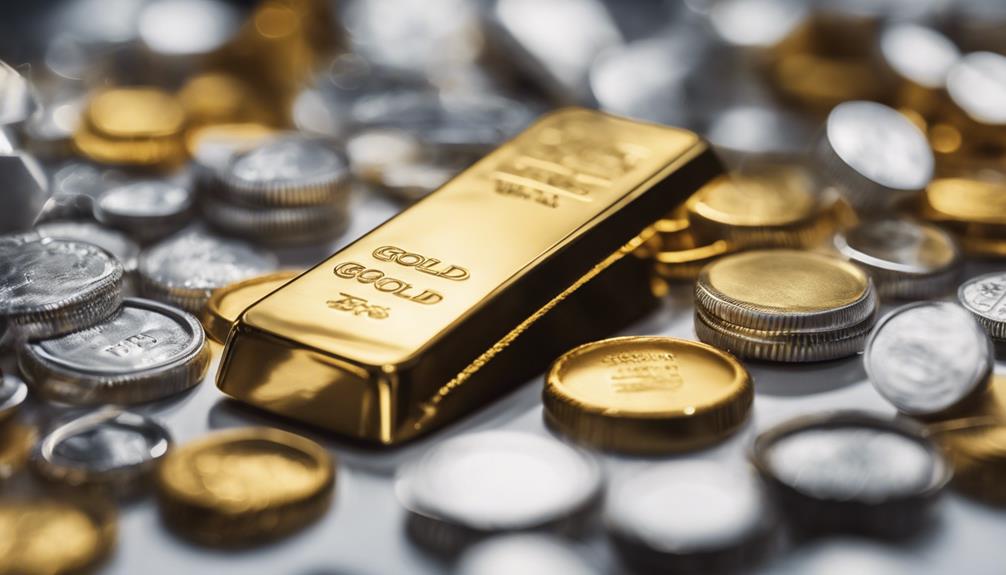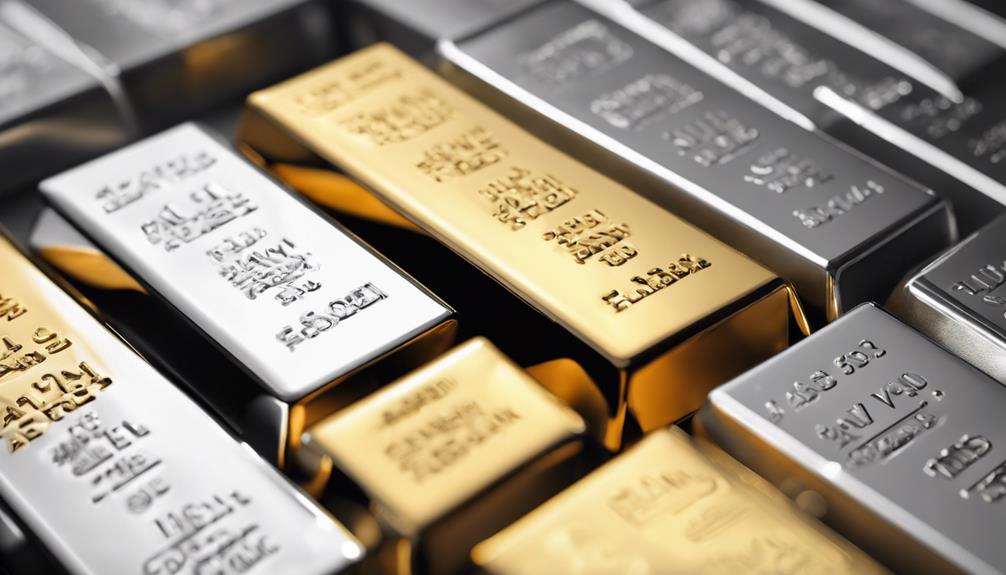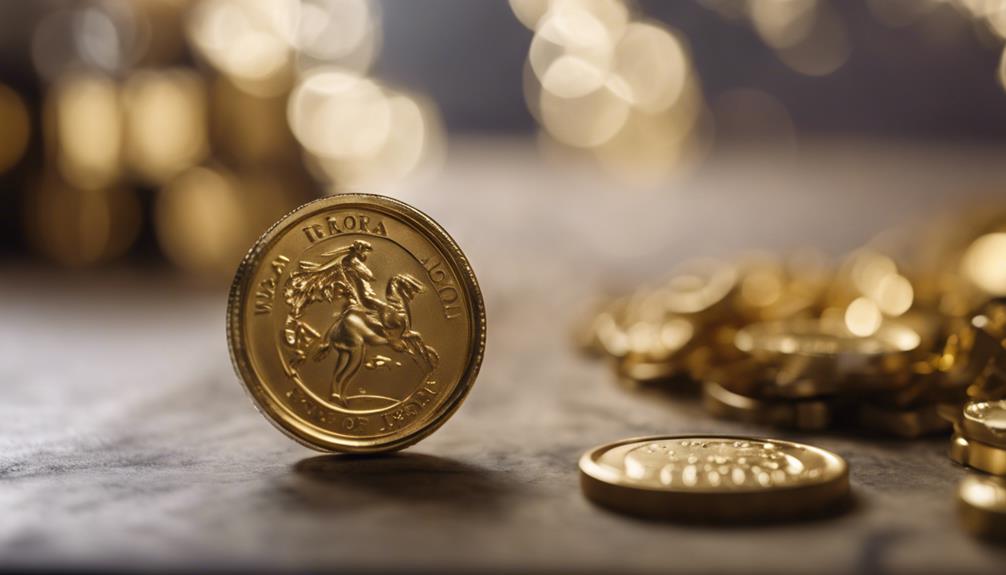Gold IRAs offer the opportunity to invest in IRS-approved metals such as gold, silver, platinum, and palladium. These metals must adhere to specific purity standards, for example, gold must be at least 99.5% pure. Silver, platinum, and palladium also have their own purity requirements. Common forms of approved metals include gold coins, bars, and rounds that meet the IRS criteria. It is recommended to look for metals that are minted by reputable sources like the US Mint or PAMP Suisse. Including metals in a Gold IRA can serve as a hedge against economic uncertainty. Precious metals provide stability and can enhance a well-rounded investment strategy. Understanding the benefits of approved metals can help improve investment decisions.
Key Takeaways
- Gold, silver, platinum, and palladium are IRS-approved metals for Gold IRAs.
- Metals must meet specific purity standards: 99.5% gold, 99.9% silver, 99.95% platinum/palladium.
- Invest in gold coins, bars, rounds, and other acceptable forms meeting IRS criteria.
- Choose reputable mints and refiners like the US Mint, Perth Mint, and PAMP Suisse.
- Diversify with metals for portfolio stability, inflation hedging, and sustainable growth.
Eligible Metals for Gold IRAs
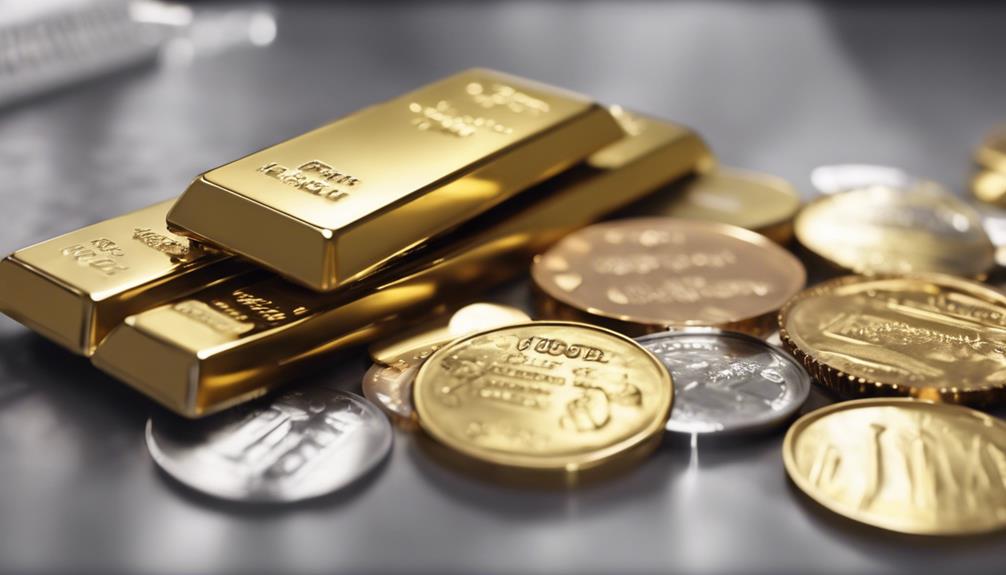
When considering eligible metals for Gold IRAs, it is essential to adhere to IRS-approved guidelines to guarantee compliance with investment regulations. Gold, silver, platinum, and palladium are among the IRS-approved metals for inclusion in a Gold IRA.
Gold coins and bars must meet specific purity standards to qualify for such investments, ensuring their authenticity and value. Similarly, silver coins and bars can also be included in a precious metals IRA, providing investors with diversification options.
Platinum and palladium coins or bars that meet the IRS criteria can also be part of a Gold IRA, offering further choices for investors looking to expand their portfolios. It's important to note that all precious metals held in a Gold IRA must be stored in an approved depository to align with IRS regulations and safeguard the investment.
Whether investors choose coins or bars, adherence to these guidelines is paramount for a successful and compliant Gold IRA investment strategy.
Purity Criteria for Approved Metals
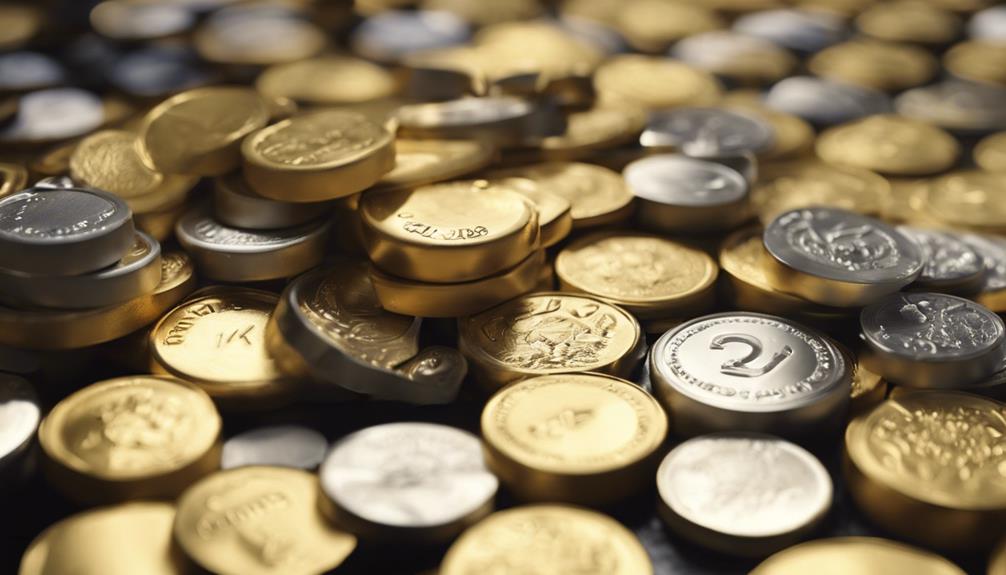
Adhering to specific purity standards is a fundamental requirement for the inclusion of gold, silver, platinum, and palladium in a Gold IRA according to IRS regulations. To guarantee compliance and authenticity of the precious metals held in a Gold IRA, the IRS has set specific purity levels for each approved metal:
- Gold must have a minimum purity of 99.5%.
- Silver needs to be at least 99.9% pure.
- Platinum and palladium must have a purity level of 99.95% for approval.
Meeting these purity criteria is vital as only IRS-approved metals that meet these standards can be included in a self-directed IRA. Maintaining compliance with these purity standards is essential for preserving the tax-advantaged status of a Gold IRA.
Investors looking to add precious metals to their retirement portfolio must make sure that the metals meet the IRS requirements for purity to enjoy the associated tax benefits.
Forms of Approved Metals

Various physical forms of approved metals, including gold, silver, platinum, and palladium, play a significant role in Gold IRAs. These metals, such as gold coins, bars, and rounds, must meet specific purity standards as outlined by the IRS. Gold, being a popular choice, is often available in the form of coins minted by government-backed mints, bars produced by accredited refineries, and rounds made by private mints.
Silver coins and bars are also accepted for investment in Gold IRAs, offering diversification options for investors. Additionally, platinum and palladium bullion in various forms are permissible for inclusion in these retirement accounts. Understanding the different physical forms of approved metals is essential for investors looking to establish a well-rounded precious metals portfolio within their Gold IRA.
Reputable Refiners and Mints
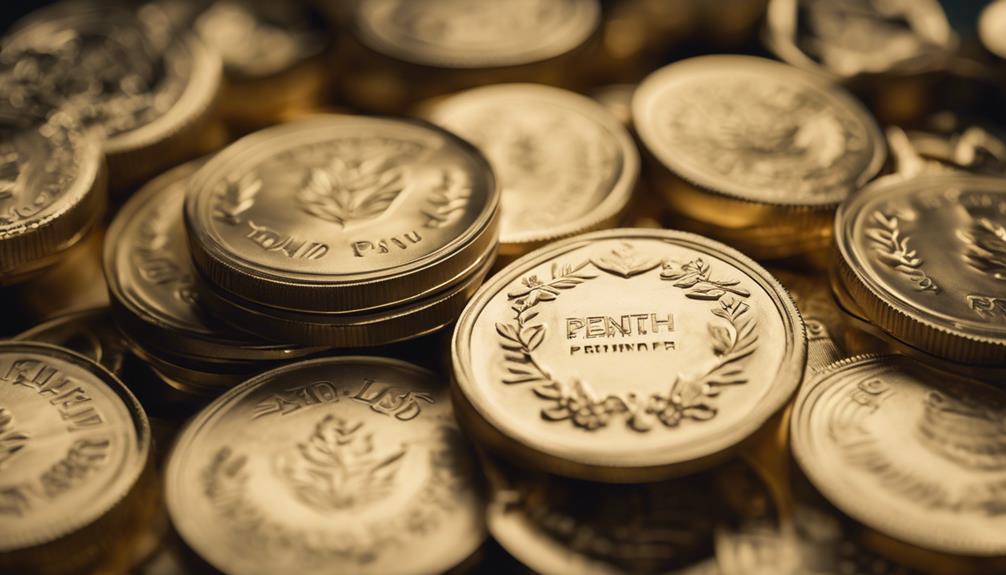
Quality assurance and trustworthiness are paramount considerations when selecting reputable refiners and mints for gold IRAs. To guarantee you make informed decisions, here are three key factors to take into account:
- Well-Known Mints: Look for products from established institutions like the United States Mint, Royal Canadian Mint, and Perth Mint. These mints produce gold coins and bars that meet IRS standards for purity and quality, providing you with confidence in their authenticity and value.
- Accredited Refiners: Consider products from reputable refiners such as PAMP Suisse, Credit Suisse, and Johnson Matthey. These entities are trusted sources for gold products in IRAs, known for their adherence to high-quality standards and reliability in the market.
- Market Acceptance: Investing in gold from recognized refiners not only ensures quality but also enhances liquidity and market acceptance for your gold IRA holdings. By choosing gold from these reputable sources, you can have trust in the integrity and value of your investment.
Benefits of Diversifying With Metals
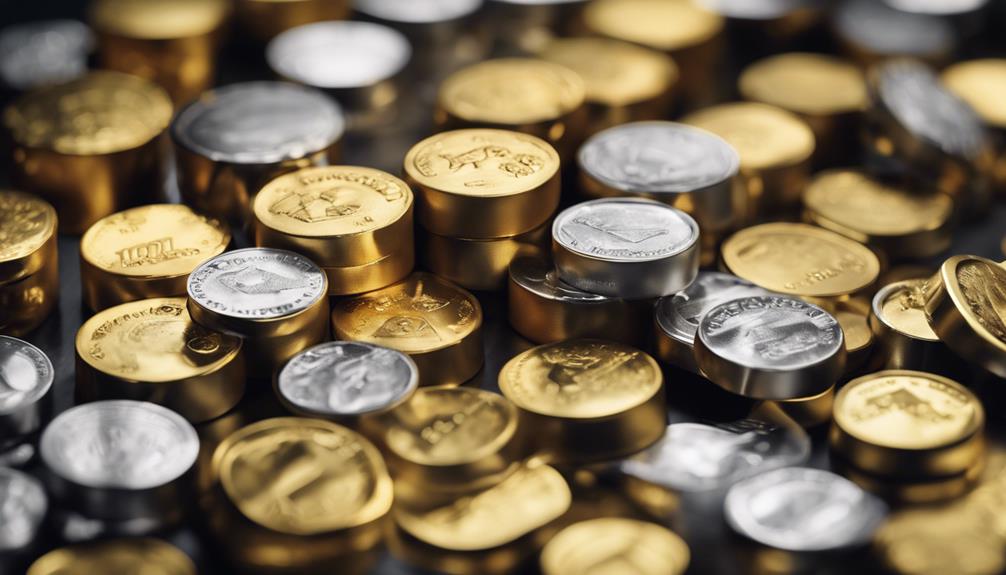
Diversifying with metals in a Gold IRA offers investors a strategic way to mitigate portfolio risk and safeguard against market volatility. By including precious metals like gold, silver, platinum, and palladium in a retirement account, individuals can diversify beyond traditional assets such as stocks and bonds.
These approved metals not only provide a hedge against economic uncertainty and inflation but also offer long-term growth potential. The stability offered by investing in metals can help safeguard wealth and preserve purchasing power over time, making them a valuable addition to a well-rounded investment portfolio.
Gold IRA investing allows individuals to balance their overall risk exposure, particularly during times of market turbulence. Incorporating metals in an IRA not only adds a layer of security but also contributes to a more robust and resilient investment strategy, enhancing the potential for sustainable growth and wealth accumulation.
Frequently Asked Questions
Can You Invest in Precious Metals in Ira?
Investing in precious metals within an IRA is possible, offering a diversified asset allocation strategy.
Precious metals like gold, silver, platinum, and palladium can be included in an IRA, subject to specific purity standards set by the IRS.
This type of investment can serve as a hedge against economic uncertainties and inflation.
Approved metals usually come in the form of bars, coins, or rounds from reputable sources, providing investors with tangible assets within their retirement accounts.
Which of the Following Is a Precious Metal Investment That Is Permitted in an IRA Account?
Gold, silver, platinum, and palladium are the precious metals permitted for investment in an IRA account. These metals must meet specific purity standards set by the IRS to qualify for inclusion in an IRA.
Investors can choose from a variety of forms, including coins, bars, and bullion, for their approved metal investments.
The inclusion of these metals in an IRA provides diversification and potential protection against market volatility.
What Is the Criteria for Gold in Ira?
When considering gold for an IRA, it must meet IRS standards for purity, requiring a minimum fineness of .995 for gold bullion bars. Only specific types of gold coins, such as American Eagle and Canadian Maple Leaf, are permissible.
Gold jewelry, collectible coins, and numismatic coins are typically not allowed. The weight and purity of the gold must be validated by an IRS-approved assayer or refiner, and the gold must be stored in an approved depository to comply with IRS regulations.
What Are the IRS Rules for Precious Metals Ira?
IRS rules for precious metals IRAs stipulate that gold, silver, platinum, and palladium must meet specific purity standards. These precious metals must be in the form of bars, rounds, or coins to qualify for inclusion in a self-directed IRA.
Approved metals for IRAs must be stored in IRS-approved depositories. Adherence to these regulations is essential to maintaining the tax-advantaged status of precious metals IRAs and ensuring security and compliance with IRS guidelines.
What are the Approved Metals for Gold IRAs and How Do They Impact Fee Structures?
When investing in gold IRAs, it’s important to know which metals are approved. The approved metals for gold IRAs include gold, silver, platinum, and palladium. The type of metal you choose can impact fee structures, as some metals may have higher storage or transaction fees. It’s important to consider this when deciding which metal to invest in.
Conclusion
In the world of investing, approved metals for Gold IRAs serve as the sturdy pillars of financial stability. Just as a well-built ship relies on strong materials to navigate rough waters, diversifying with metals can help investors weather economic storms.
By adhering to purity criteria and choosing reputable refiners, one can build a solid foundation for their investment portfolio. Remember, in the domain of Gold IRAs, the right metals can be the key to long-term success.
